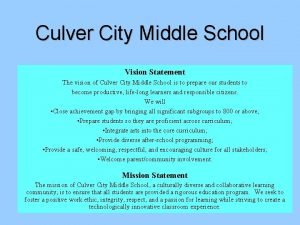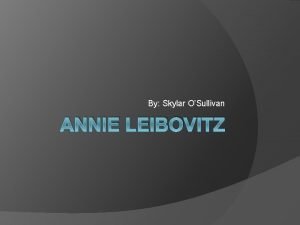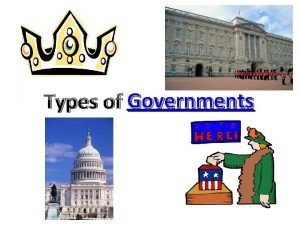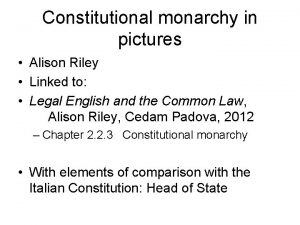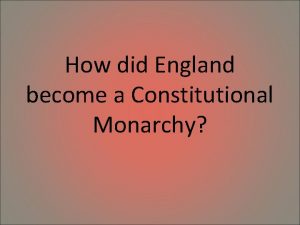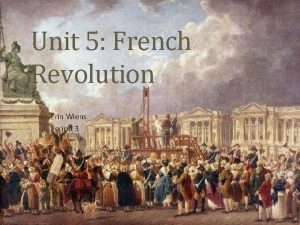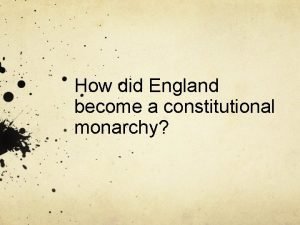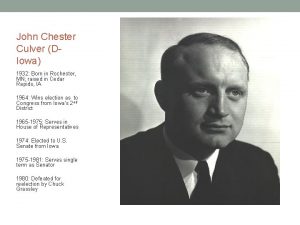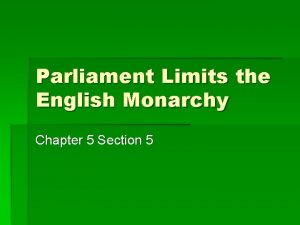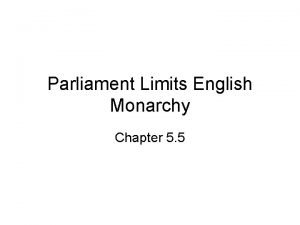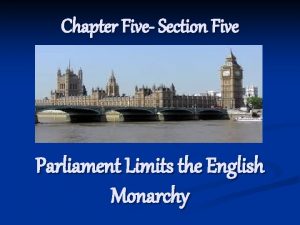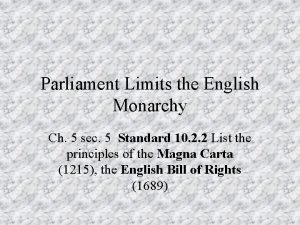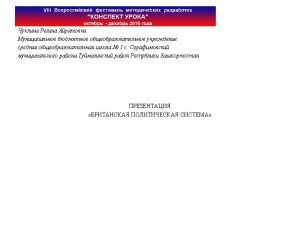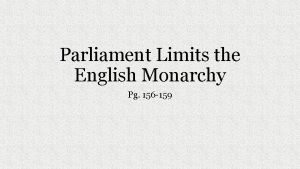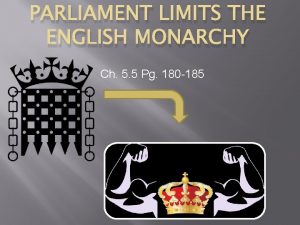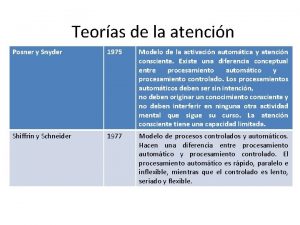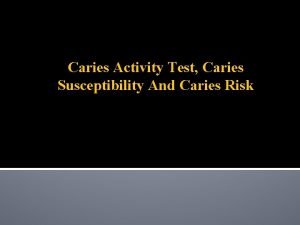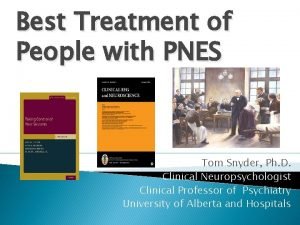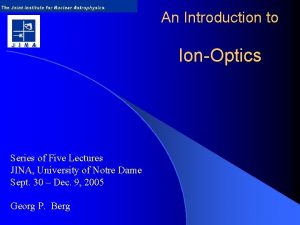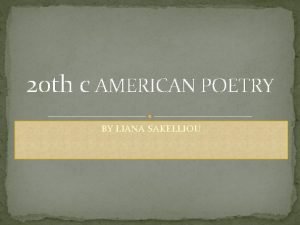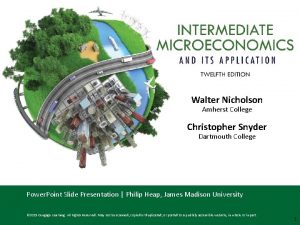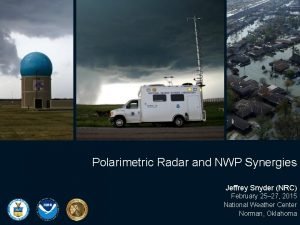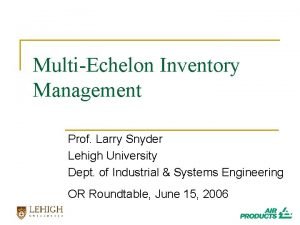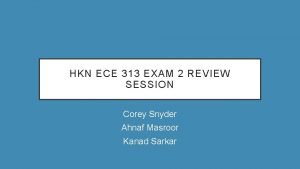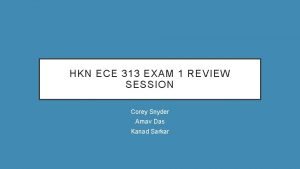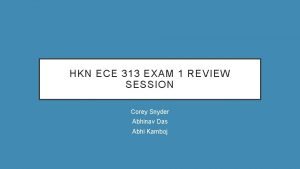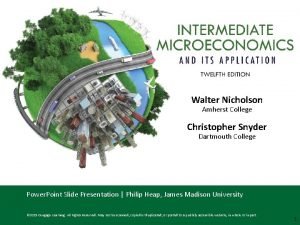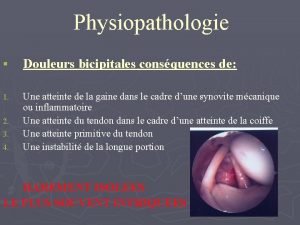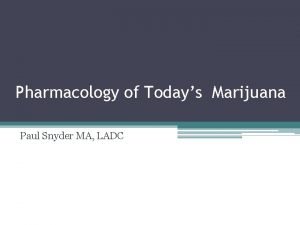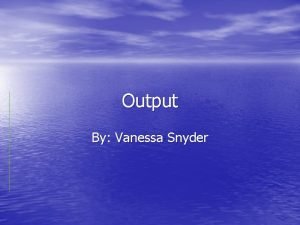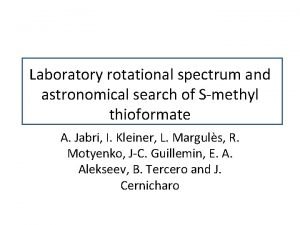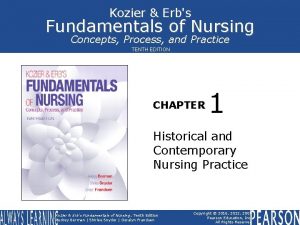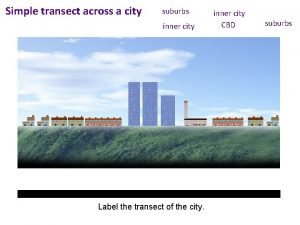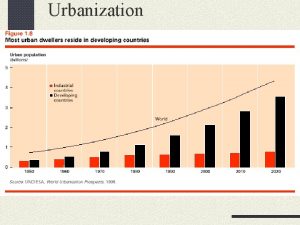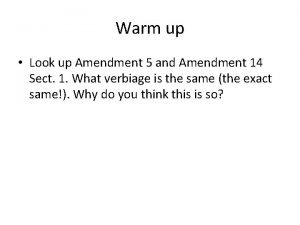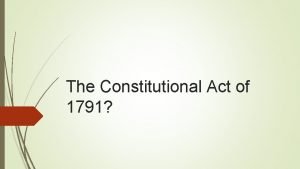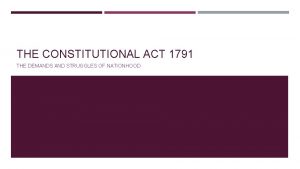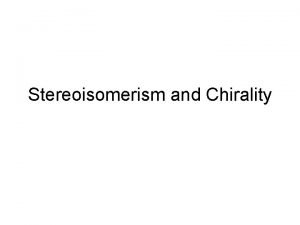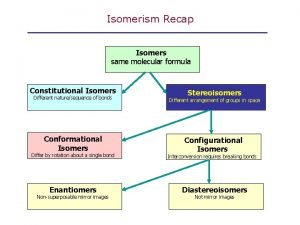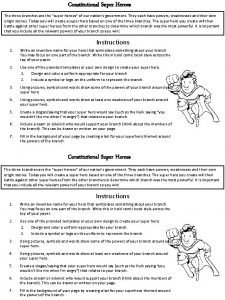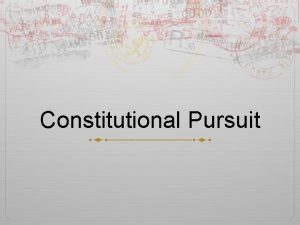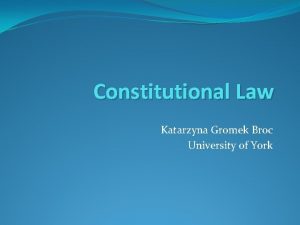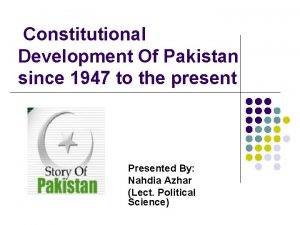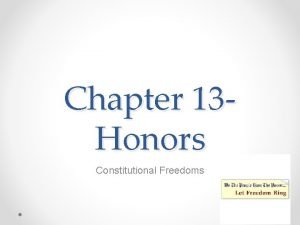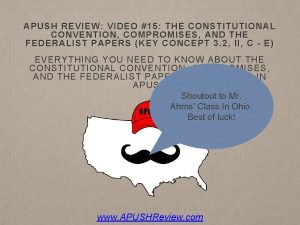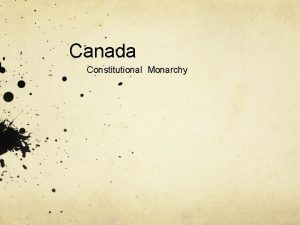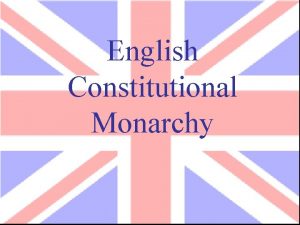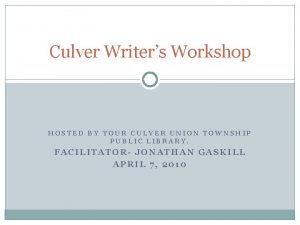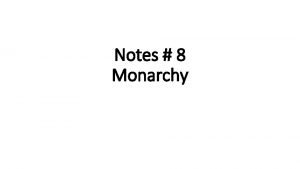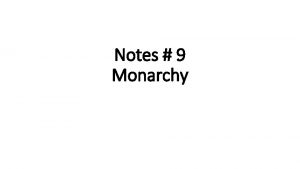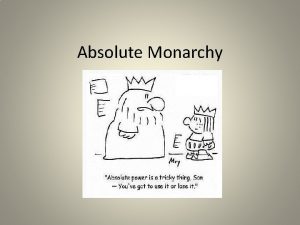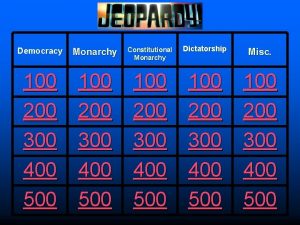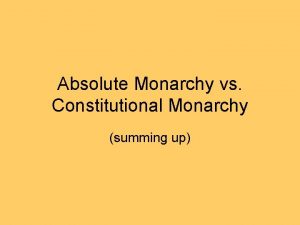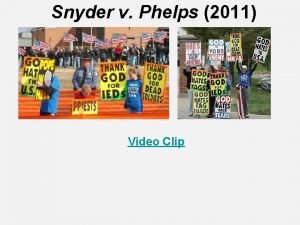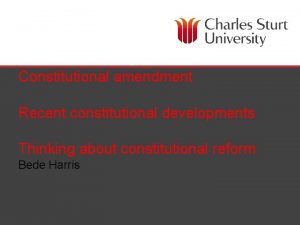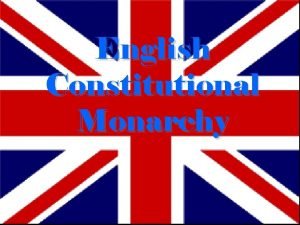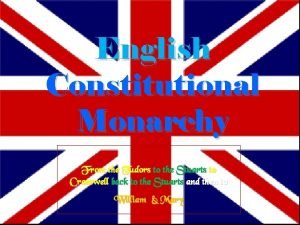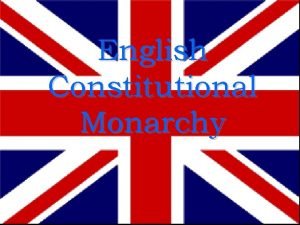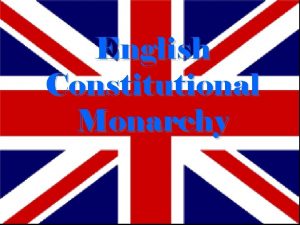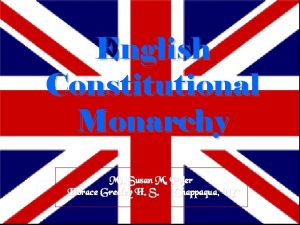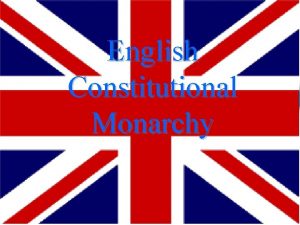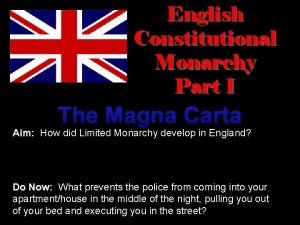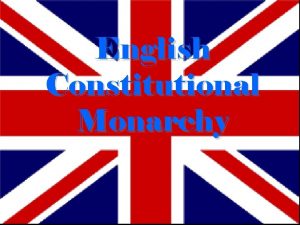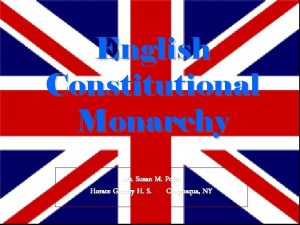English Constitutional Monarchy Ms Snyder Culver City High








![James I [r. 1603 -1625] James I’s speech to the House of Commons: I James I [r. 1603 -1625] James I’s speech to the House of Commons: I](https://slidetodoc.com/presentation_image_h/1df2338f6adde0a31269e0d5b22cdbe5/image-9.jpg)
![James I [r. 1603 -1625] a Wanted absolute power. a Alienated a Parliament grown James I [r. 1603 -1625] a Wanted absolute power. a Alienated a Parliament grown](https://slidetodoc.com/presentation_image_h/1df2338f6adde0a31269e0d5b22cdbe5/image-10.jpg)
![James I [r. 1603 -1625] a Problems he faced: § Large royal debt. § James I [r. 1603 -1625] a Problems he faced: § Large royal debt. §](https://slidetodoc.com/presentation_image_h/1df2338f6adde0a31269e0d5b22cdbe5/image-11.jpg)
![James I [r. 1603 -1625] Religious Problems a He alienated the Puritans by his James I [r. 1603 -1625] Religious Problems a He alienated the Puritans by his](https://slidetodoc.com/presentation_image_h/1df2338f6adde0a31269e0d5b22cdbe5/image-12.jpg)




![Charles I [r. 1625 -1649] a Pro-ceremonies and rituals. a Uniformity of church services Charles I [r. 1625 -1649] a Pro-ceremonies and rituals. a Uniformity of church services](https://slidetodoc.com/presentation_image_h/1df2338f6adde0a31269e0d5b22cdbe5/image-17.jpg)




![Ship Money Assessments, 1636 [per square mile] a A medieval tax for coastal cities Ship Money Assessments, 1636 [per square mile] a A medieval tax for coastal cities](https://slidetodoc.com/presentation_image_h/1df2338f6adde0a31269e0d5b22cdbe5/image-22.jpg)









![Oliver Cromwell [1599 -1658] † Officer of the Parliamentary army [cavalry] the New Model Oliver Cromwell [1599 -1658] † Officer of the Parliamentary army [cavalry] the New Model](https://slidetodoc.com/presentation_image_h/1df2338f6adde0a31269e0d5b22cdbe5/image-32.jpg)

![The “Interregnum” Period [1649 -1660] † The Commonwealth (1649 -1653) † The Protectorate (1654 The “Interregnum” Period [1649 -1660] † The Commonwealth (1649 -1653) † The Protectorate (1654](https://slidetodoc.com/presentation_image_h/1df2338f6adde0a31269e0d5b22cdbe5/image-34.jpg)



![The Puritan Commonwealth [1649 -1653] † Constitutional Republic § Created a constitution Instrument of The Puritan Commonwealth [1649 -1653] † Constitutional Republic § Created a constitution Instrument of](https://slidetodoc.com/presentation_image_h/1df2338f6adde0a31269e0d5b22cdbe5/image-38.jpg)

![The Protectorate [1653 -1660] † Cromwell tears up the ineffective Constitution. † Dismisses the The Protectorate [1653 -1660] † Cromwell tears up the ineffective Constitution. † Dismisses the](https://slidetodoc.com/presentation_image_h/1df2338f6adde0a31269e0d5b22cdbe5/image-40.jpg)

![King Charles II [r. 1660 -1685] a Restored theaters and reopened the pubs and King Charles II [r. 1660 -1685] a Restored theaters and reopened the pubs and](https://slidetodoc.com/presentation_image_h/1df2338f6adde0a31269e0d5b22cdbe5/image-42.jpg)
![King Charles II [r. 1660 -1685] a 1661 “Cavalier” Parliament [filled with Royalists] § King Charles II [r. 1660 -1685] a 1661 “Cavalier” Parliament [filled with Royalists] §](https://slidetodoc.com/presentation_image_h/1df2338f6adde0a31269e0d5b22cdbe5/image-43.jpg)


![King Charles II [r. 1660 -1685] a 1673 Test Act § Parliament excluded all King Charles II [r. 1660 -1685] a 1673 Test Act § Parliament excluded all](https://slidetodoc.com/presentation_image_h/1df2338f6adde0a31269e0d5b22cdbe5/image-46.jpg)

![King James II [r. 1685 -1688] a Was a convert to Catholicism a Provoked King James II [r. 1685 -1688] a Was a convert to Catholicism a Provoked](https://slidetodoc.com/presentation_image_h/1df2338f6adde0a31269e0d5b22cdbe5/image-48.jpg)
![King James II [r. 1685 -1688] a Catholics in High Command a Standing army King James II [r. 1685 -1688] a Catholics in High Command a Standing army](https://slidetodoc.com/presentation_image_h/1df2338f6adde0a31269e0d5b22cdbe5/image-49.jpg)


![English Bill of Rights [1689] a It settled all of the major issues between English Bill of Rights [1689] a It settled all of the major issues between](https://slidetodoc.com/presentation_image_h/1df2338f6adde0a31269e0d5b22cdbe5/image-52.jpg)
![English Bill of Rights [1689] a Main provisions : 1. The King could not English Bill of Rights [1689] a Main provisions : 1. The King could not](https://slidetodoc.com/presentation_image_h/1df2338f6adde0a31269e0d5b22cdbe5/image-53.jpg)

- Slides: 54

English Constitutional Monarchy Ms. Snyder (Culver City High School) Ms. Susan M. Pojer Horace Greeley H. S. Chappaqua, NY

Background (1215 -1603)

Magna Carta, 1215 a A list of demands made by the nobility. a CONTRACT a Established principles which limited the power of the king: § Established basic legal rights. § The king must ask for consent for taxes. § “Rule of Law” § Accused must have jury trial. -Due Process

Model Parliament, 1295 a King Edward I a Military leaders & nobility together = Parliament to ask their consent to new taxes. a “Power of the purse. ”

The Elizabethan “Bargain” a Parliament: § Power to tax. § Can debate and amend disputed bills. a The Monarch: § Royal prerogative [right/choice] on foreign policy.

English Society by Transformed 1600 • Nobility no longer play vital military role • Increasing gentry (wealthy landowners) • Losing authority in government – House of Commons near = to House of Lords

The Early Stuarts (1603 -1649)

The Stuart Monarchy
![James I r 1603 1625 James Is speech to the House of Commons I James I [r. 1603 -1625] James I’s speech to the House of Commons: I](https://slidetodoc.com/presentation_image_h/1df2338f6adde0a31269e0d5b22cdbe5/image-9.jpg)
James I [r. 1603 -1625] James I’s speech to the House of Commons: I am surprised that my ancestors should ever be permitted such an institution to come into existence. I am a stranger, and found it here when I arrived, so that I am obliged to put up with what I cannot get rid of!
![James I r 1603 1625 a Wanted absolute power a Alienated a Parliament grown James I [r. 1603 -1625] a Wanted absolute power. a Alienated a Parliament grown](https://slidetodoc.com/presentation_image_h/1df2338f6adde0a31269e0d5b22cdbe5/image-10.jpg)
James I [r. 1603 -1625] a Wanted absolute power. a Alienated a Parliament grown accustomed to “balance polity. ”
![James I r 1603 1625 a Problems he faced Large royal debt James I [r. 1603 -1625] a Problems he faced: § Large royal debt. §](https://slidetodoc.com/presentation_image_h/1df2338f6adde0a31269e0d5b22cdbe5/image-11.jpg)
James I [r. 1603 -1625] a Problems he faced: § Large royal debt. § Believed in Divine Right of Kings. § Clashed with Parliament v. He raised money without Parliament’s consent!
![James I r 1603 1625 Religious Problems a He alienated the Puritans by his James I [r. 1603 -1625] Religious Problems a He alienated the Puritans by his](https://slidetodoc.com/presentation_image_h/1df2338f6adde0a31269e0d5b22cdbe5/image-12.jpg)
James I [r. 1603 -1625] Religious Problems a He alienated the Puritans by his strong defense of the Anglican Church. a Threatened to drive Puritans from England =>

“Holy Commonwealth” In September 1620 a small group of Puritans went to the New World because of constant persecution! “The Pilgrims”


Gunpowder Plot, 1605 a An attempt by some Catholics to kill King James I a Blow up the House of Lords during the state opening of Parliament. Guy Fawkes

“Speeches to Parliament” 1609 -1610 • Laid down claim to rule by Divine Right. • By 1611, James had enough of Parliament • Ruled by himself until 1621
![Charles I r 1625 1649 a Proceremonies and rituals a Uniformity of church services Charles I [r. 1625 -1649] a Pro-ceremonies and rituals. a Uniformity of church services](https://slidetodoc.com/presentation_image_h/1df2338f6adde0a31269e0d5b22cdbe5/image-17.jpg)
Charles I [r. 1625 -1649] a Pro-ceremonies and rituals. a Uniformity of church services imposed by a church court. § Anglican Book of Common Prayer for both England AND Scotland.

• Belief in Divine Right • Seen as too pro. Catholic and too anti-Puritan by the Puritans.

Many Types of Puritans • All were Calvinist • Believed in predestination and need to purify the Church

Charles I & Parliament a Constantly at war with Spain and France. § Always need £/$, but how to get it? ?

Charles I & Parliament a Periodically, Parliament would deny funds. § In return, Charles would dissolve Parliament and try to rule England without it find funds in other ways. v. Forced “loans, ” selling aristocratic titles, “ship money”, etc…
![Ship Money Assessments 1636 per square mile a A medieval tax for coastal cities Ship Money Assessments, 1636 [per square mile] a A medieval tax for coastal cities](https://slidetodoc.com/presentation_image_h/1df2338f6adde0a31269e0d5b22cdbe5/image-22.jpg)
Ship Money Assessments, 1636 [per square mile] a A medieval tax for coastal cities for defense. a Charles applied them to inland counties as well.

The Petition of Rights, 1628 § No imprisonment without due cause. § No taxation without Parliament’s consent. § No putting soldiers in private homes. § No martial law during peacetime.

The Petition of Rights, 1628 a Charles signed it, and then ignored it, dissolving Parliament!

The “Short” Parliament a Calls Parliament into session in 1640 § Charles dismisses them after 3 weeks. Charles I by Van Dyck (1633)

The “Long” Parliament a Technically in session from 1640 to 1660. § Laud executed. § Triennial Act passed Parliament must be called in session at least once every 3 yrs. § Parliament can’t be adjourned without its own consent!

Grand Remonstrance • Parliament led by John Pym • Outlined evils of Charles’s rule

Charles and Parliament • January 1642 Charles I attempts to arrest 5 members of Parliament


The Civil War (1642 -1649)

Civil War (1642 -1649) Royalists Parliamentarians (Cavaliers) (Roundheads) a House of Lords † House of Commons a N & W England † S & E England a Aristocracy † Puritans a Large landowners † Merchants a Church officials † Townspeople a More rural † More urban
![Oliver Cromwell 1599 1658 Officer of the Parliamentary army cavalry the New Model Oliver Cromwell [1599 -1658] † Officer of the Parliamentary army [cavalry] the New Model](https://slidetodoc.com/presentation_image_h/1df2338f6adde0a31269e0d5b22cdbe5/image-32.jpg)
Oliver Cromwell [1599 -1658] † Officer of the Parliamentary army [cavalry] the New Model Army. † Led the army that defeated royal forces and now controlled the government.

The Interregnum (1649 -1660)
![The Interregnum Period 1649 1660 The Commonwealth 1649 1653 The Protectorate 1654 The “Interregnum” Period [1649 -1660] † The Commonwealth (1649 -1653) † The Protectorate (1654](https://slidetodoc.com/presentation_image_h/1df2338f6adde0a31269e0d5b22cdbe5/image-34.jpg)
The “Interregnum” Period [1649 -1660] † The Commonwealth (1649 -1653) † The Protectorate (1654 -1660)

Pride’s Purge, 1648 † Cromwell purges the House of Commons of moderates [anyone who isn’t anti-monarchy]. † The results is the “Rump” Parliament.

Regicide Beheading of Charles I, 1649 † The vote by the Rump Parliament was 68 -67.

![The Puritan Commonwealth 1649 1653 Constitutional Republic Created a constitution Instrument of The Puritan Commonwealth [1649 -1653] † Constitutional Republic § Created a constitution Instrument of](https://slidetodoc.com/presentation_image_h/1df2338f6adde0a31269e0d5b22cdbe5/image-38.jpg)
The Puritan Commonwealth [1649 -1653] † Constitutional Republic § Created a constitution Instrument of Government § An executive [Cromwell] § A Council of State annually elected the committee of Parliament. § No monarch. † Europe is appalled other nations don’t recognize it.

Cromwell Dissolves the “Rump” Parliament in 1653
![The Protectorate 1653 1660 Cromwell tears up the ineffective Constitution Dismisses the The Protectorate [1653 -1660] † Cromwell tears up the ineffective Constitution. † Dismisses the](https://slidetodoc.com/presentation_image_h/1df2338f6adde0a31269e0d5b22cdbe5/image-40.jpg)
The Protectorate [1653 -1660] † Cromwell tears up the ineffective Constitution. † Dismisses the Rump Parliament and rules with the support of the military. § Declares martial law. § Military dictator. † Religious tolerance for all [esp. for Jews], except for Catholics. † Crushes a rebellion in Scotland. † Crushes a rebellion among the Catholics of Ireland kills 40% of all ethnic Irish!

The Restoration (1660 -1688) Parliament could no more exist without the Crown than the Crown without Parliament. This was the most important lesson of the English Civil War!
![King Charles II r 1660 1685 a Restored theaters and reopened the pubs and King Charles II [r. 1660 -1685] a Restored theaters and reopened the pubs and](https://slidetodoc.com/presentation_image_h/1df2338f6adde0a31269e0d5b22cdbe5/image-42.jpg)
King Charles II [r. 1660 -1685] a Restored theaters and reopened the pubs and brothels closed during the Restoration. a Favored religious toleration. a Had secret Catholic sympathies.
![King Charles II r 1660 1685 a 1661 Cavalier Parliament filled with Royalists King Charles II [r. 1660 -1685] a 1661 “Cavalier” Parliament [filled with Royalists] §](https://slidetodoc.com/presentation_image_h/1df2338f6adde0a31269e0d5b22cdbe5/image-43.jpg)
King Charles II [r. 1660 -1685] a 1661 “Cavalier” Parliament [filled with Royalists] § Disbanded the Puritan army. § Pardoned most Puritan rebels. § Restored the authority of the Church of England. a 1662 Clarendon Code [Act of Uniformity] § All clergy & church officials had to conform to the Anglican Book of Common Prayer. § It forbade “non-conformists” to worship publicly, teach their faith, or attend English universities.

Great London Plague, 1665

Great London Fire, 1666
![King Charles II r 1660 1685 a 1673 Test Act Parliament excluded all King Charles II [r. 1660 -1685] a 1673 Test Act § Parliament excluded all](https://slidetodoc.com/presentation_image_h/1df2338f6adde0a31269e0d5b22cdbe5/image-46.jpg)
King Charles II [r. 1660 -1685] a 1673 Test Act § Parliament excluded all but Anglicans from civilian and military positions. [to the Anglican gentry, the Puritans were considered “radicals” and the Catholics were seen as “traitors!”] a 1679 Habeas Corpus Act § Any unjustly imprisoned persons could obtain a writ of habeas corpus compelling the govt. to explain why he had lost his liberty.

Charles II’s Foreign Policy 1665 – 1667: Second Anglo-Dutch War a To Charles II, Louis XIV is an ideal ally against the Dutch. a 1670 Treaty of Dover
![King James II r 1685 1688 a Was a convert to Catholicism a Provoked King James II [r. 1685 -1688] a Was a convert to Catholicism a Provoked](https://slidetodoc.com/presentation_image_h/1df2338f6adde0a31269e0d5b22cdbe5/image-48.jpg)
King James II [r. 1685 -1688] a Was a convert to Catholicism a Provoked the revolution that Charles II had succeeded in avoiding!
![King James II r 1685 1688 a Catholics in High Command a Standing army King James II [r. 1685 -1688] a Catholics in High Command a Standing army](https://slidetodoc.com/presentation_image_h/1df2338f6adde0a31269e0d5b22cdbe5/image-49.jpg)
King James II [r. 1685 -1688] a Catholics in High Command a Standing army a few miles outside of London. a Catholic advisors a Claimed the power to suspend or dispense with Acts of Parliament. a 1687 Declaration of Liberty of Conscience army and navy. § He extended religious toleration without Parliament’s approval or support.

The Glorious Revolution 1688

The “Glorious” Revolution: 1688 a Whig & Tory leaders offered the throne jointly to James II’s daughter Mary [raised a Protestant] & her husband, William of Orange. § He was a vigorous enemy of Louis XIV. § He was seen as a champion of the Protestant cause.
![English Bill of Rights 1689 a It settled all of the major issues between English Bill of Rights [1689] a It settled all of the major issues between](https://slidetodoc.com/presentation_image_h/1df2338f6adde0a31269e0d5b22cdbe5/image-52.jpg)
English Bill of Rights [1689] a It settled all of the major issues between King & Parliament. a It served as a model for the U. S. Bill of Rights. a It also formed a base for the steady expansion of civil liberties in the 18 c and early 19 c in England.
![English Bill of Rights 1689 a Main provisions 1 The King could not English Bill of Rights [1689] a Main provisions : 1. The King could not](https://slidetodoc.com/presentation_image_h/1df2338f6adde0a31269e0d5b22cdbe5/image-53.jpg)
English Bill of Rights [1689] a Main provisions : 1. The King could not suspend the operation of laws. 2. The King could not interfere with the ordinary course of justice. 3. No taxes levied or standard army maintained in peacetime without Parliament’s consent. 4. Freedom of speech in Parliament. 5. Sessions of Parliament would be held frequently. 6. Subjects had the right of bail, petition, and freedom from excessive fines and cruel and unusual punishment. 7. The monarch must be a Protestant. 8. Freedom from arbitrary arrest. 9. Censorship of the press was dropped. 10. Religious toleration.

The Seesaw of King & Parliament: 16031689
 Culver city middle school
Culver city middle school Demi moore, culver city, california, 1991
Demi moore, culver city, california, 1991 Culver city parks and recreation after school program
Culver city parks and recreation after school program Who governs dictatorship
Who governs dictatorship Constitutional monarchy pictures
Constitutional monarchy pictures When did england become a constitutional monarchy
When did england become a constitutional monarchy Conclusion of french revolution
Conclusion of french revolution When did england become a constitutional monarchy
When did england become a constitutional monarchy Chester john culver
Chester john culver Beth culver
Beth culver Chapter 5 section 5 parliament limits the english monarchy
Chapter 5 section 5 parliament limits the english monarchy Parliament limits the english monarchy
Parliament limits the english monarchy Parliament limits the english monarchy answer key
Parliament limits the english monarchy answer key Parliament limits the english monarchy
Parliament limits the english monarchy England prime minister
England prime minister Parliament limits the english monarchy
Parliament limits the english monarchy Parliament limits the english monarchy
Parliament limits the english monarchy Posner y snyder
Posner y snyder Chard-snyder fsa
Chard-snyder fsa Snyder agar test
Snyder agar test Thomas snyder mental health
Thomas snyder mental health Snyder notation
Snyder notation Gary snyder love poem
Gary snyder love poem Chris snyder dartmouth
Chris snyder dartmouth Snyder radar
Snyder radar Qqn stock
Qqn stock Faa hypertension worksheet
Faa hypertension worksheet Uiuc ece 329
Uiuc ece 329 Ece 329 uiuc
Ece 329 uiuc Ece 313
Ece 313 Christopher snyder dartmouth
Christopher snyder dartmouth Snyder slap classification
Snyder slap classification Paul snyder killer
Paul snyder killer Snyder printer
Snyder printer Marlene snyder
Marlene snyder Sarah snyder mega
Sarah snyder mega Snyder 2016
Snyder 2016 Berman snyder & frandsen 2016
Berman snyder & frandsen 2016 Snyder introduction to the california condor download
Snyder introduction to the california condor download Latin city model
Latin city model Cbd inner city outer city
Cbd inner city outer city Is mexico city a primate city
Is mexico city a primate city Procedural vs substantive due process
Procedural vs substantive due process Constitutional act of 1791
Constitutional act of 1791 Constitutional act 1791
Constitutional act 1791 Constitutional isomer
Constitutional isomer Right to constitutional remedies
Right to constitutional remedies C6h14 chain isomers
C6h14 chain isomers Diastereomers vs enantiomers
Diastereomers vs enantiomers Judicial branch superhero names
Judicial branch superhero names Constitutional pursuit answer sheet
Constitutional pursuit answer sheet Scope of constitutional law
Scope of constitutional law Constitutional development in pakistan from 1947 to 1973
Constitutional development in pakistan from 1947 to 1973 Gitlow v new york constitutional question
Gitlow v new york constitutional question Constitutional compromises
Constitutional compromises
